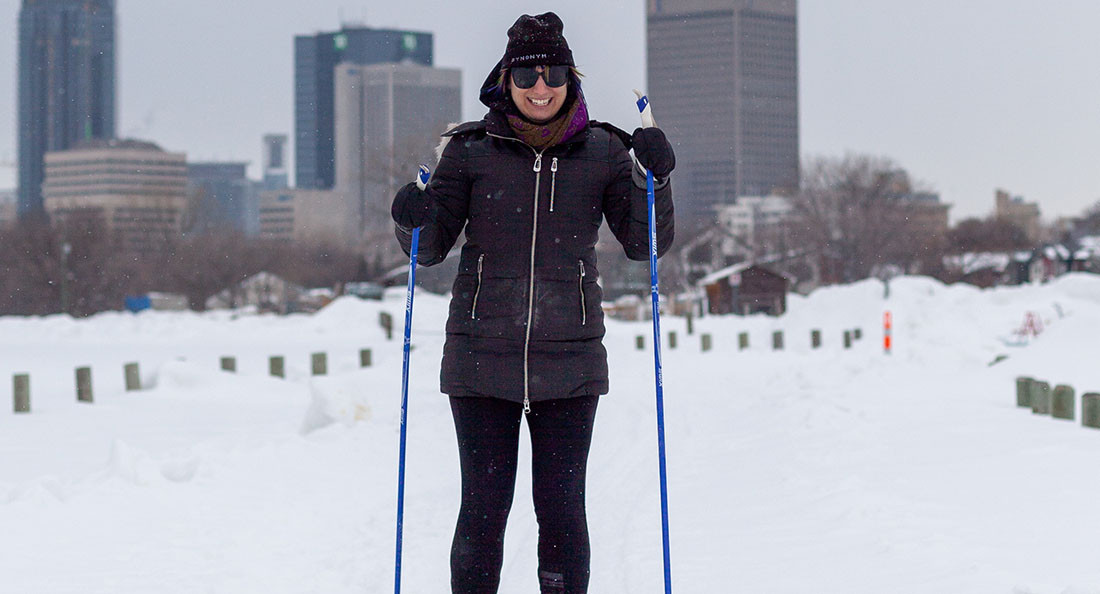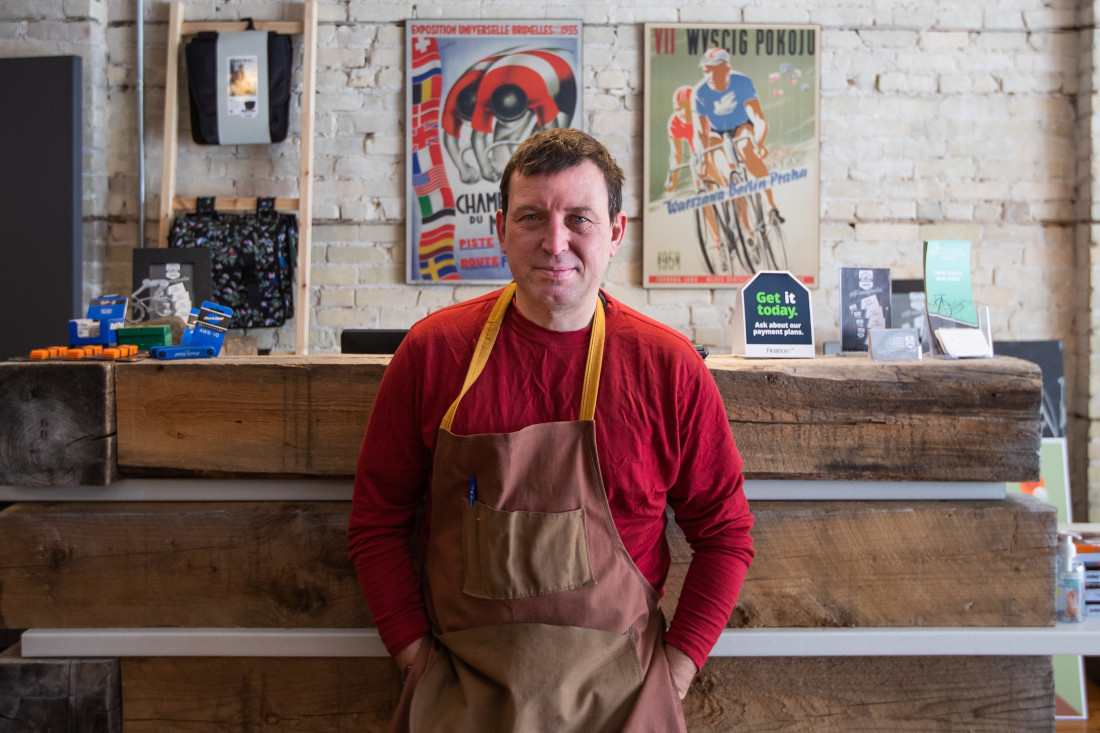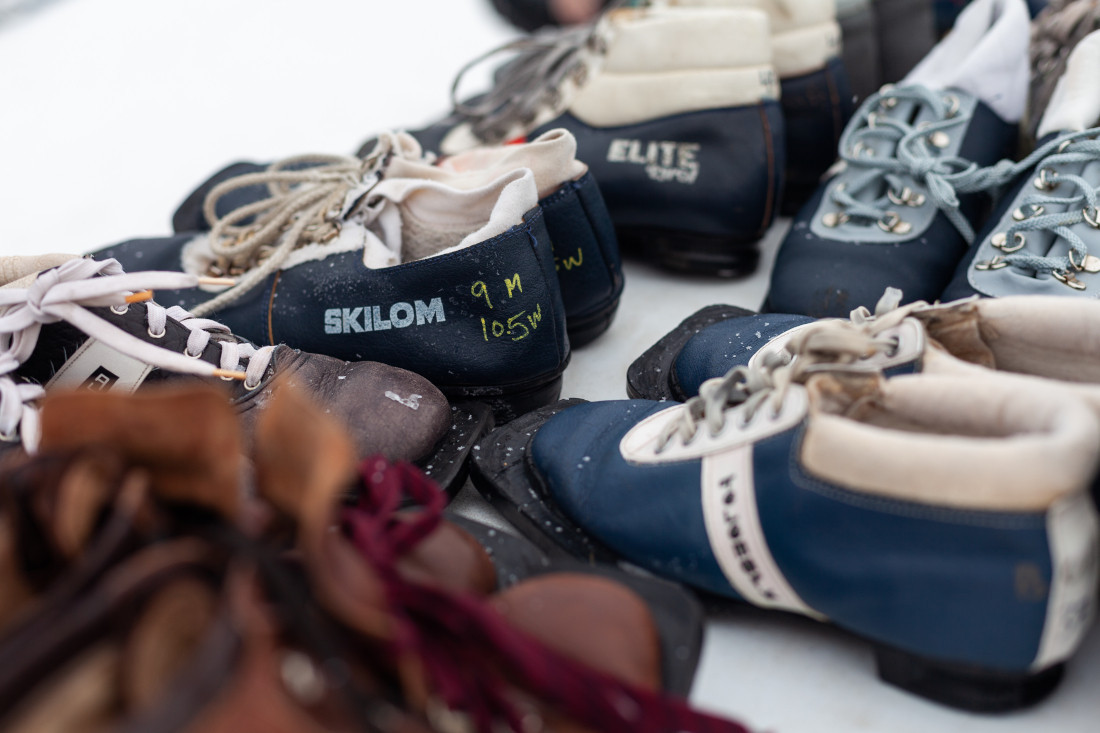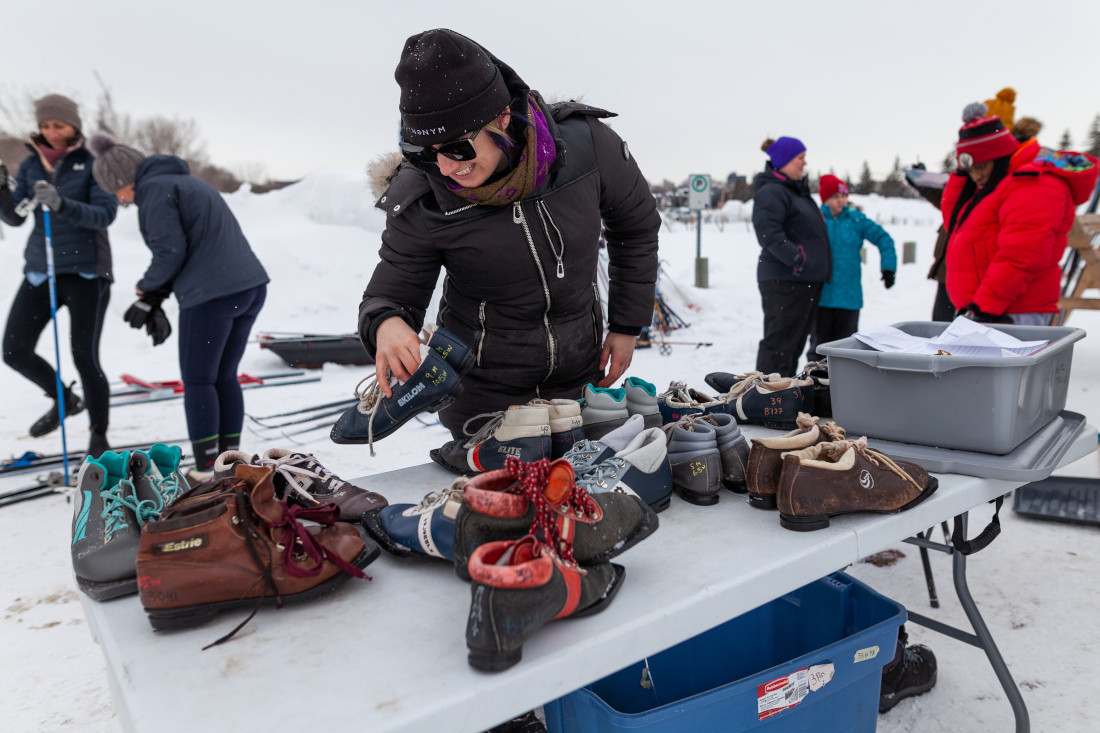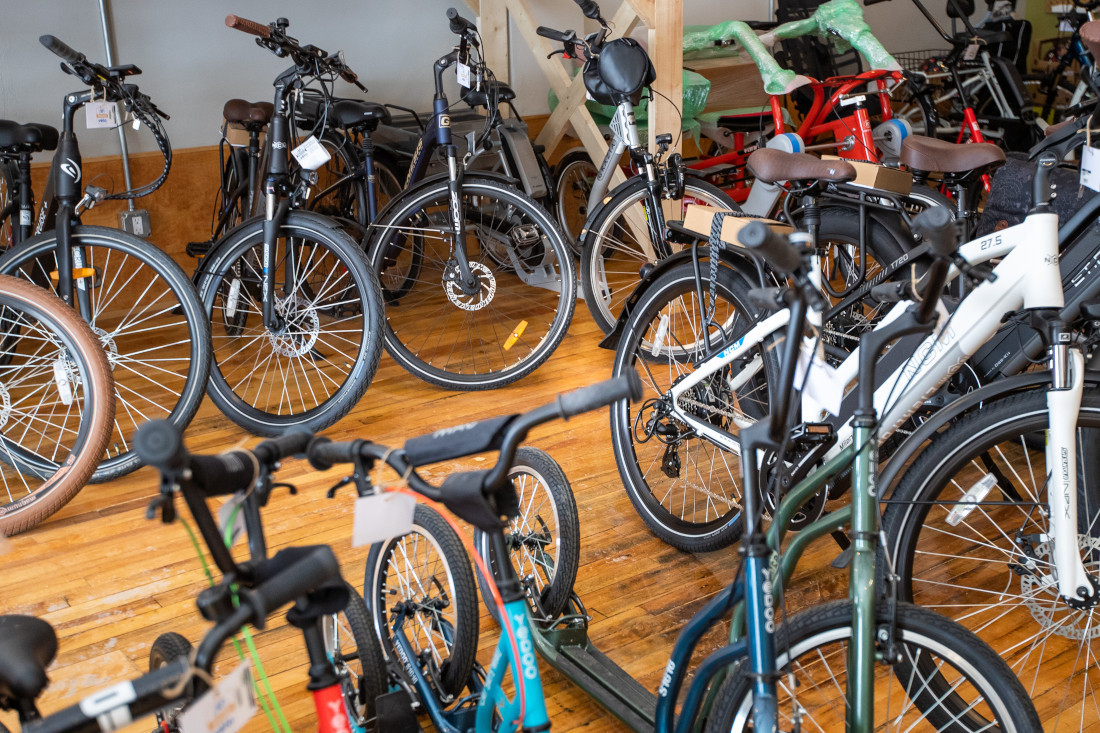A city for all
Putting accessibility at the centre of active transportation
Kirby Cote, from Accessible Sport Manitoba and Winnipeg Trails, cross-country skis at Whittier Park.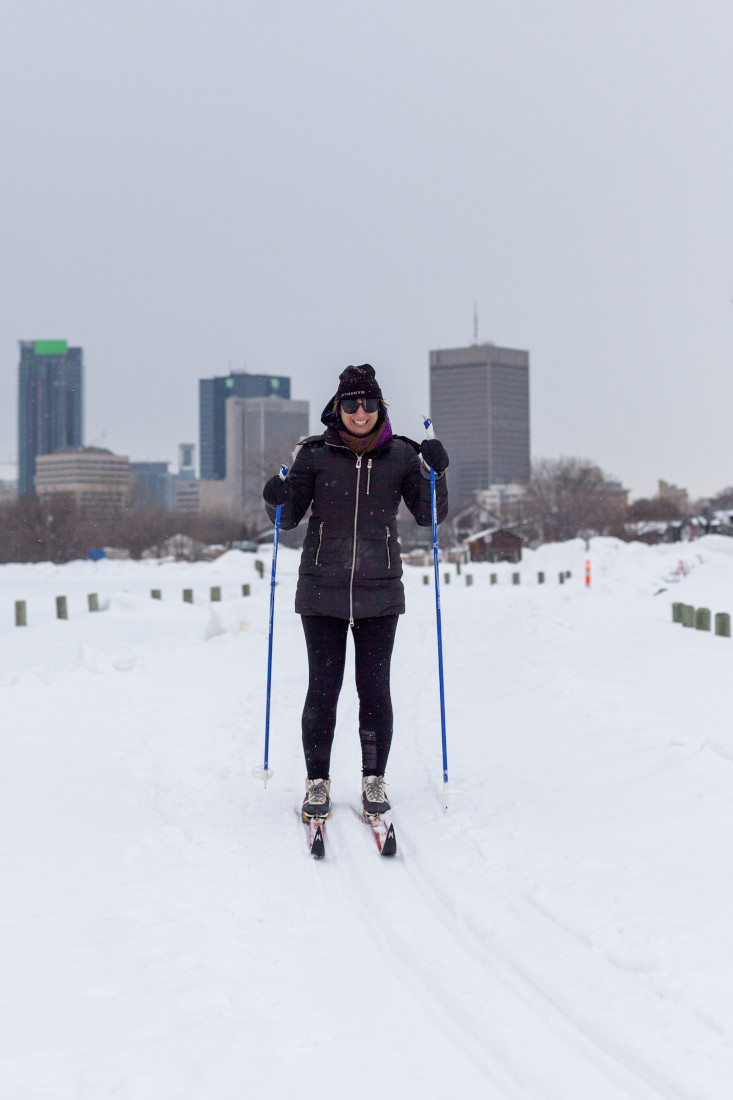
Active transportation (including cycling, walking and skiing) is an ecologically friendly way to get around that allows people to stay active and be outside in their communities. Bike lanes, the Open Streets initiative and the river trail are all part of Winnipeg’s existing active-transportation networks. As this infrastructure is further developed and Winnipeg reimagines how residents exist in a city together, advocates say accessibility must be at the heart of design processes.
Infrastructure troubles
Brian Szklarczuk co-founded the cycle and ski shop Prairie Velo in order to provide more options for adaptive bicycles to meet people’s different mobility needs.
Adaptive features can take many forms. Hand-powered bicycles change the source of propulsion, three-wheeled bikes (or trikes) add stability, and bikes that ride side-by-side allow two people to ride together, each pedalling as much or as little as they want. Even smaller things like finding a more comfortable seat are considered part of adaptivity.
However, the city’s cycling infrastructure isn’t always built with different needs in mind.
“With my hearing disability, I have no hearing on my right side when I ride,” Szklarczuk says. This becomes a major problem on sections of Winnipeg’s bike-lane network such as the Wolseley loop, which includes a sharp 90-degree turn in front of Balmoral Hall.
“I physically can’t turn my neck to see the cars the way they’ve done the cut out. It (frustrates) me that nobody actually thought, ‘is this a safe corner?’”
Protected bike lanes are important for making all forms of active transportation safer. Without them, cyclists either pedal alongside fast-moving car traffic or opt to cycle on sidewalks, putting pedestrians and people using mobility aids in danger.
Sometimes, however, protected bike lanes make the city more difficult to navigate when using Winnipeg Transit Plus, a door-to-door transit service offered to those whose physical disabilities mean the fixedroute transit system is inaccessible.
Karina Cardona Claros is the fundraising manager for Canadian Association of Physicians for the Environment and a disability justice advocate.
“Protected bike lanes actually create barriers for people using Transit Plus. (The placement of these lanes mean) you can’t get dropped off in front of the building or space that you’re supposed to get dropped off in front of,” she says.
There are also problems with connecting Winnipeg’s active-transportation routes. With Winnipeg’s current bike infrastructure, many routes abruptly end or lose their protective lanes.
“It’s about creating continuity for people,” Cardona Claros says. “We can’t just have some aspects of it be accessible, and then it drops off, and the last two kilometres aren’t, because then the whole route is inaccessible.”
Winnipeg has a long way to go before active transportation is a viable option for many people. For Mark Cohoe, executive director of Bike Winnipeg, the goal is that “as soon as you head out the door, you’re on a roadway or a pathway that’s comfortable for you and that provides you access all the way to your destination.”
Once infrastructure is created, it must also be maintained with repairs and snow removal in the winter in order to remain functional year-round.
A group of cross country skiers at Whittier Park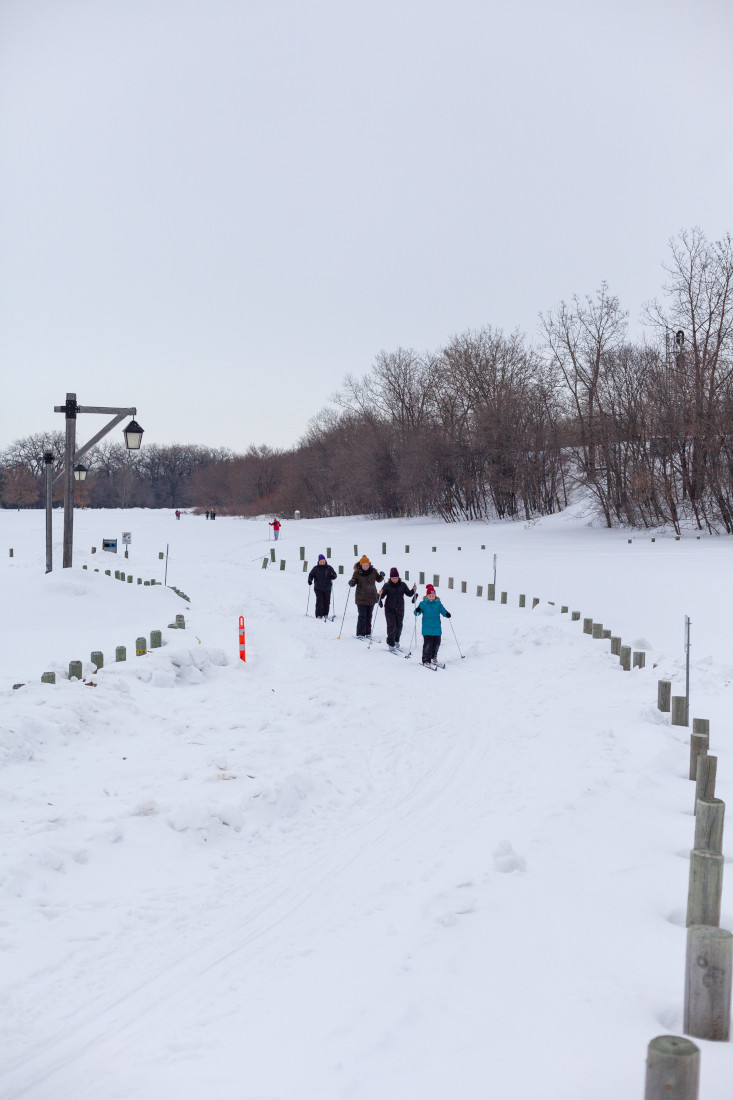
Overlapping needs
While many may assume active transportation is limited to self-propelled options, Cardona Claros takes a more expansive view.
“For the most part, we talk about bicycles and commuters, and we don’t talk about what it means for people to use (lanes with) a scooter, in a walker – all the things we could be using these lanes for,” she says.
Often, active-transportation lanes are made with fast-riding cyclists in mind. This leaves out many people who use mobility aids, parents with kids in tow and those who just want to go at a slower pace.
Kirby Cote is a disabled active-transportation advocate who works as the vice-president of the board at Accessible Sport Connection Manitoba and as the active aging coordinator for Winnipeg Trails. She says her guiding approach to accessibility is that “if you make something functional for our most vulnerable population, it improves every single person’s life in that area.”
“There’s often this thing where people think if it’s accessible, it’s not going to be fun,” Cote says. “I think that’s just a misconception of what a person with a disability wants when they say they want more accessible spaces.”
In Manitoba, one in six people are disabled. Accessibility can take many forms to meet different people’s needs.
“Accessibility might mean clearer transit planning for one person. For another person, it might mean a certain kind of friendliness from the bus driver, or it might mean a certain kind of seating arrangement,” Cardona Claros says.
There are many different ways of moving oneself around the city, and people have different transportation needs. Accessibility should not be relegated to the end of a design process as an afterthought. A just transition to a more ecologically friendly city needs to embrace the many ways people get around at the core of its vision.
Slowing down, reaching out
Transportation doesn’t just mean people getting across the city as fast as possible from point A to point B. People go out for leisure or to meet up with friends. For many, a slower pace makes the city safer and creates more opportunities for people to build community with one another.
For Szklarczuk, this all starts with noticing others around you.
“Taking the time to say hi on a regular ride, taking the time to slow down and wave – that’s a big part of it,” he says.
While planning a city for people’s leisure rather than work might sound idealistic to some, Cardona Claros points out that “it’s actually how people live when we have different options and know that we aren’t just expected to keep up a certain pace.”
Cardrona Claros says the stakes of accessible design go beyond inclusion.
“We can develop a sense of ownership of those spaces, but if they’re built with these other ideas in mind that exclude disabled people, then there’s already a barrier to accepting any community ownership of that space, because it’s not for us,” she says.
One active-transportation program that received widespread enthusiasm is Winnipeg’s Open Streets initiative. Starting in the summer of 2020 in response to the COVID-19 pandemic, the City of Winnipeg limited daytime motor-vehicle traffic to one block on 10 routes throughout the city. This gave pedestrians, cyclists and people using mobility aids places to be active and socially distanced with only limited interactions with cars.
For Szklarczuk, Open Streets was very positive, as it “gives the perception that I’m in a safe area with no cars or limited vehicles.”
The speed of cars is a major risk factor for those trying to share the road using active transportation. One proposal put forward by groups like the Green Action Centre is to lower the speed limit of all residential streets to 30 km/h.
“If we can get the speed down to 30 km/h, a lot of our streets are pretty good at that point,” Cohoe says.
But major challenges remain for orienting the city toward communities that are accessible to all. For one thing, Winnipeg is marked by geographic divides, such as the Canadian Pacific Railway marshalling yards, which divide the North End from the rest of the city. Cohoe explains that “there’s essentially one safe crossing on your bike at Higgins and Annabella. Really, it’s not the greatest crossing at that.”
Cote also notes that there are few accessible entryways to Winnipeg’s river trails in the winter.
“It’s such a valuable piece of our city as far as creating community and movement, and it basically doesn’t serve any person with a disability. So figuring out a way to utilize that space would be pretty fantastic,” she says.
The cost of justice
Kirby Cote from Accessible Sport Manitoba and Winnipeg Trails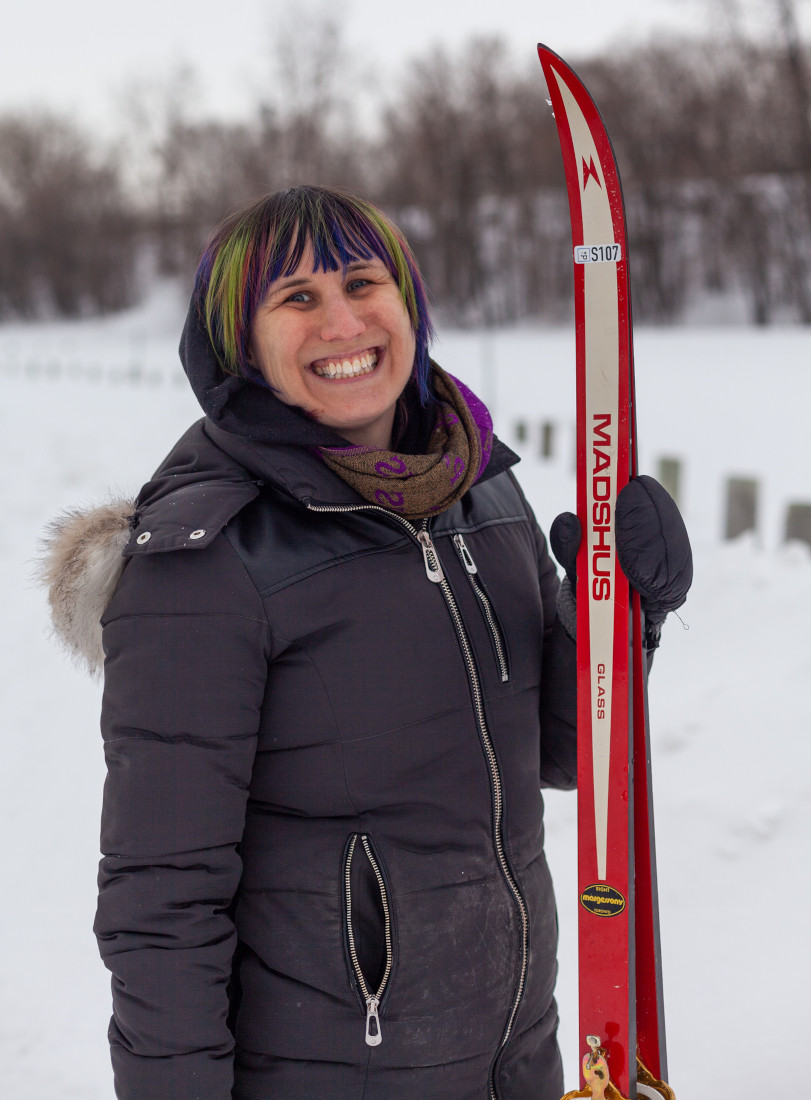
“We’re so used to saying disability is too expensive,” Cardona Claros says. “Sometimes, we don’t consider what the cost of inaction is on people’s lives, and we just expect people to be okay with exclusion.”
Cohoe is optimistic about the financial benefits of prioritizing active transportation.
“The city is going to benefit, because we can’t really afford the way we’ve built out our city. It’s just too little infrastructure for too few people, and it hasn’t proved sustainable,” he says.
Cost isn’t something that can just be quantified in a dollar amount. This way of measuring the value of an infrastructure project misses the impacts on the environment, as well as individual and community wellbeing.
From a purely financial perspective, consultation and accessible design always show up in the negative as additional “costs” to a project. For Cardona Claros, this way of thinking misses the responsibility of prioritizing accessibility and limits the possibilities for what a city can be.
“We created cities that blocked people from being a part of them, and if we want disabled people to be a part of the city and not be so excluded and marginalized in so many ways, we need to stop thinking of disability as an extra cost. It’s the cost of justice.”
Published in Volume 76, Number 21 of The Uniter (March 17, 2022)

